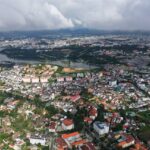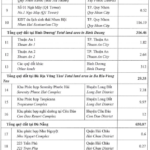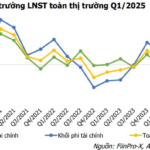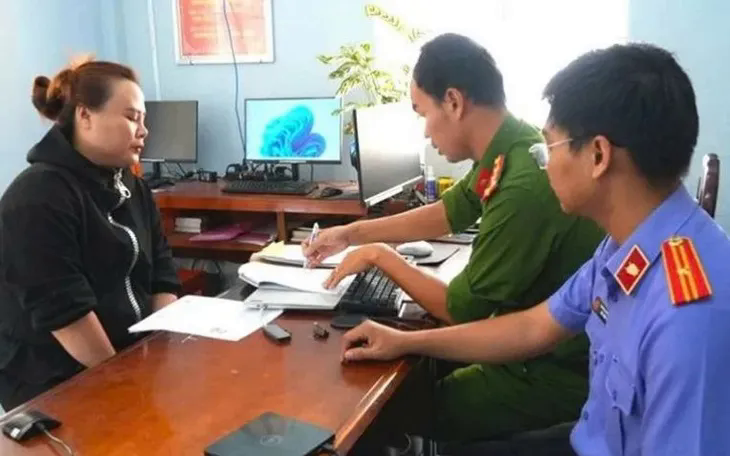“Multiplying Growth”
According to experts, once the provincial-level administrative units are rearranged, there will be more room for development, a larger population, and abundant resources. Mr. Tran Ngoc Chinh, former Deputy Minister of Construction, shared, “If two provinces are merged into one, the infrastructure will be more synchronized, interconnected, and easier to link with each other. If each province has its own project, criteria, and small-scale operations, it will be difficult to create a breakthrough in growth.” He added that when a province has a large enough scale in terms of resources, manpower, and area, it will not only harness the strength of that province but also have a positive impact on the whole region.
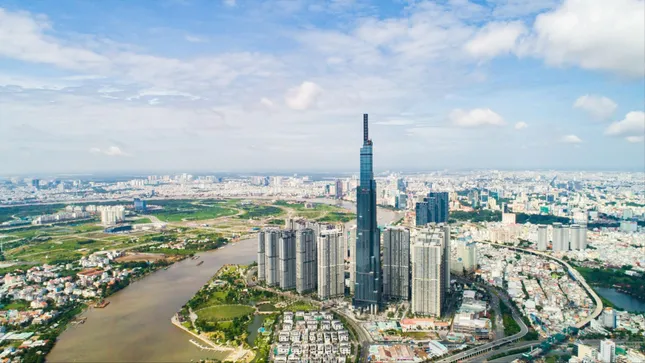
New development spaces emerge as Binh Duong and Ba Ria-Vung Tau merge with Ho Chi Minh City. Image source: Chinhphu.vn
Sharing the same view, Prof. Dr. Tran Hoang Ngan, a deputy of the Ho Chi Minh City National Assembly delegation, opined that if the current administrative boundaries remain unchanged, the development potential of the provinces will gradually diminish, making it challenging to achieve a breakthrough. Using the development of Ho Chi Minh City, Binh Duong, and Ba Ria-Vung Tau as an example, Prof. Dr. Tran Hoang Ngan affirmed that merging these three localities into one would unlock a development space full of potential. “When Ho Chi Minh City includes Binh Duong and Ba Ria-Vung Tau, the advantages of each locality will not only accumulate but also create a synergistic effect, resulting in superior performance. Developing a free trade area or the Thi Vai-Cai Mep port will only be truly effective if it is linked to Ho Chi Minh City’s goal of becoming an international financial center,” said Mr. Ngan.

According to National Assembly deputy Tran Hoang Ngan, rearranging provincial-level administrative units is not just addition; it can become a multiplier for development. Image source: NHAT MINH
Similarly, Ba Ria-Vung Tau, with its beautiful coastline, must connect with Ho Chi Minh City’s economic center, which offers high-end services and a large customer base, to develop sea tourism, according to Mr. Ngan. Binh Duong, known as the industrial capital, relies on Ho Chi Minh City’s or Ba Ria-Vung Tau’s ports for its exports. “When these three localities are rearranged into one, administrative procedures, transportation procedures, and logistics will be simplified and expedited. As a result, goods will move more smoothly, costs will be reduced, processing speed will increase, and an efficient value chain will be formed. In addition, the new Ho Chi Minh City will become a regional-scale center for finance, economics, education, healthcare, and culture. Human resources among the localities will be flexibly and efficiently redeployed,” said the deputy of the Ho Chi Minh City National Assembly delegation.
Based on the opportunities and advantages created, Prof. Dr. Tran Hoang Ngan asserted that merging administrative units at the provincial level is not just addition; it is a multiplier for development. “Merging administrative units at the provincial level is not just 1 + 1 = 2 or 1 + 1 + 1 = 3; it is a multiplier for development. If we can maximize the potential, advantages, and vast development space, Ho Chi Minh City’s growth rate after the expansion will not just be an addition around the 6% mark; it can break through to 11-12%,” said Mr. Ngan.
Mr. Tran Ngoc Chinh, former Deputy Minister of Construction, suggested that rearranging provincial-level administrative units could uncover new growth poles. Regarding the Central Highlands region, he explained that if the five provinces in the region are only connected internally, their development potential and capacity will be limited. However, when they receive support and linkage from coastal central provinces such as Phu Yen, Khanh Hoa, and Binh Dinh, new growth poles with great potential between the “highlands and the sea” will be fostered.
Mr. Nguyen Tien Dinh, former Deputy Minister of Home Affairs, particularly emphasized the quality of officials after rearranging provincial-level administrative units. “The scale of the provincial level will be very large, so the qualifications of officials and civil servants executing tasks must also be higher to meet the requirements of new jobs assigned by law. Therefore, the arrangement and selection of officials for leadership positions in the provinces and cities after the rearrangement are crucial to the success of the revolution in streamlining the organizational apparatus,” said Mr. Dinh.
“New Body” Requires New Management Thinking
However, merging territories will not create a breakthrough if the “new body” continues to operate with old thinking and mechanisms. According to experts, the province merger aims not only to reduce the number of administrative units but also to redesign the country’s development space. The administrative map should not merely be a boundary but must reflect substantive socio-economic linkages.
“We live in an age where connection speed, integration capacity, and inter-regional momentum determine competitive advantage. A central city with a strong industrial hinterland, a seamless system of seaports, flexible capital, and diverse human resources will be the driving force for the entire region. But this will only happen if administrative barriers and procedural boundaries are removed,” said Mr. Ngan.
Mr. Ha Sy Dong, a deputy of the Quang Tri National Assembly delegation and a former leader of the province for many terms, stated that when rearranging provincial-level administrative units and organizing local governments according to a two-tier model, there is an urgent need to promote decentralization and delegation of authority and eliminate the “asking-giving” mechanism. He cited an example from the field of public investment: although funds have been allocated, and localities have prepared the land, they still have to wait for the opinions of central ministries and sectors on technical design and investment lists, resulting in prolonged delays. “The money is in our pocket, but we can’t spend it; we have to keep it in the State Treasury or banks. That’s why there’s a delay in disbursing public investment capital,” said Mr. Dong.
To make the province merger a “multiplier” for development rather than just an addition, Mr. Ngan suggested promoting decentralization and delegation with the direction of “localities decide, localities do, and localities take responsibility.” “Localities need to be more proactive in matters of local budget deficit and local public debt. Super cities like Hanoi and Ho Chi Minh City, which are currently focusing on infrastructure investment, need to be given more authority,” he added.
From a management perspective, Mr. Tran Anh Tuan, former Deputy Minister of Home Affairs, argued that the biggest obstacle to decentralization is trust. The central government does not fully trust the localities, and the localities lack confidence in themselves. As a result, even when authority is delegated, it still has to be “asked back” to be exercised. “I give it to you, but before you decide, you still have to ask me. If I give you the authority but don’t let you use it, it’s like I never gave it to you in the first place,” Mr. Tuan emphasized.
Therefore, in parallel with the province merger, experts suggested establishing a new governance mechanism where the central government focuses on its role as a creator, not performing specific tasks but focusing on strategy formulation, institution, and law building; while localities are given the authority and held accountable. “Ultimately, merging provinces is not just a geographical equation; it is an opportunity to rethink large-scale development. When administrative barriers are removed, when the new mechanism is flexible and transparent, and when the new apparatus truly takes action, the multiplier for growth will become a reality,” said Mr. Tran Hoang Ngan.
Redrawing Boundaries, Reshaping Human Resources
In addition to the institutions, the human factor is also crucial. According to Prof. Dr. Tran Hoang Ngan, merging administrative units at the provincial level is also an opportunity to reassess the apparatus in terms of organization, thinking, and the capacity of officials. He proposed that after the merger, a clear timeline (3-6 months) should be set to review the apparatus and assess the capacity of officials. “Anyone who is not suitable should be replaced immediately. We cannot keep people who cannot keep up with the new machine just because of sentimental reasons,” he said.
Sharing the same view, Mr. Le Viet Truong, former Vice Chairman of the National Assembly’s Committee for Defense and Security, suggested that there should be a revolution in evaluating, arranging, and selecting officials to ensure that those with real talent and virtue are chosen for the apparatus. “The Party and State have set very high requirements for national development in the new era. However, achieving these goals will be challenging without a cadre of strategic-level officials with both talent and virtue,” said Mr. Truong.
KBSV and PVCB Capital: A Strategic Alliance, Expanding the Financial Ecosystem
Recognizing the untapped potential in the field of investment and asset management, particularly in catering to the needs of the younger generation seeking financial freedom, KBSV and PVCB Capital have joined forces. Together, they aim to introduce exceptional services that comprehensively address the needs of investors.
“Phat Dat Targets Triple Revenue for 2025”
At the upcoming Annual General Meeting on June 27, the leadership team of Phat Dat Real Estate Development JSC (HOSE: PDR) plans to present an ambitious business plan for 2025. With a target of VND 3.2 trillion in total revenue and VND 907 billion in pre-tax profits, the company aims to surpass the previous year’s performance by 2.5 and 3.5 times, respectively. If these goals are met, 2025 will be remembered as the most profitable year for PDR in the recent period from 2023 to 2025.
Unlocking THACO’s 2025 Vision: Strategically Navigating Challenges to Boost Profits and Transform Performance
In 2024, THACO recorded a remarkable consolidated after-tax profit of VND 3,228 billion, with the majority of this success attributed to the outstanding performance of Thaco Auto. Thaco Auto’s impressive contribution stood at VND 4,410 billion in consolidated pre-adjusted tax profit, showcasing its pivotal role in driving THACO’s overall profitability.
“6 Undervalued Stocks to Buy Now: Top Picks for Q2 With Strong Earnings Growth Potential”
The VN-Index is predicted to fluctuate within the range of 1,300-1,350 points, according to our expert analysts. This movement indicates a differentiation and rotation of investment funds among stock groups, each with its own unique investment narrative.


